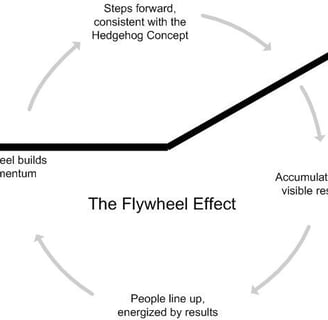How the B.E.S.T Model Can Drive Jim Collins' Flywheel Effect?
In the realm of business success, Jim Collins' Flywheel Effect emerges as a cornerstone concept for achieving unstoppable momentum and long-term growth. When paired with the B.E.S.T Model (Best, Expected, Standard, Terrible) by Abdullah MAQ, this dynamic framework amplifies organizational efforts, creating a sustainable cycle of progress, consistency, and peak performance. Together, they empower businesses to turn deliberate actions into exponential results.
Abdullah MAQ
12/21/20243 min read


What is Jim Collins' Flywheel Effect?
The Flywheel Effect, introduced in Jim Collins' book "Good to Great," describes the momentum businesses build through consistent efforts over time. Instead of relying on a single breakthrough moment, success is achieved by making incremental improvements, which collectively create unstoppable momentum—like pushing a heavy flywheel that eventually spins on its own.
What is the B.E.S.T Model?
The B.E.S.T Model is a performance evaluation framework designed to categorize and measure outcomes across four levels:
Best: Exceptional performance beyond expectations.
Expected: Satisfactory and reliable outcomes.
Standard: Minimum acceptable performance.
Terrible: Below-par results that need immediate attention.
By setting clear definitions for each level, organizations can systematically assess their operations and drive improvements.
How the B.E.S.T Model Fuels the Flywheel Effect
Clarity of Goals (Aligning Effort with Best Practices)
The B.E.S.T Model establishes precise performance metrics. When employees know what "Best" looks like, they can focus their energy on achieving it. This clarity reduces wasted effort and ensures every push on the flywheel is deliberate and aligned with long-term goals.Example: A sales team defines "Best" as exceeding monthly targets by 20%. With this benchmark, every effort is geared toward pushing the sales flywheel with consistent and measurable actions.
Building Momentum (Incremental Improvements)
The Flywheel Effect thrives on small, consistent wins. The B.E.S.T Model encourages continuous assessment and adjustment. By identifying "Standard" or "Terrible" outcomes, businesses can course-correct and transform weaknesses into strengths.Example: If customer service ratings fall into the "Standard" category, targeted training can elevate performance to "Best." Each improvement boosts the momentum of the flywheel.
Creating a Culture of Excellence (Best vs. Expected)
The B.E.S.T Model fosters a culture where "Expected" is not the end goal. Organizations striving for "Best" ensure teams never settle for mediocrity. This relentless pursuit of excellence compounds over time, propelling the flywheel faster.Example: A manufacturing company uses the B.E.S.T Model to track product quality. Even when meeting "Expected" standards, the team innovates processes to achieve "Best" outcomes, enhancing efficiency and customer satisfaction.
Avoiding Pitfalls (Managing Terrible Outcomes)
Jim Collins emphasizes that businesses falter when complacency or arrogance sets in. The B.E.S.T Model safeguards against this by regularly spotlighting underperformance ("Terrible") and addressing it proactively. This ensures the flywheel never loses momentum due to overlooked issues.Example: A marketing campaign delivers "Terrible" results in lead generation. By quickly analyzing the failure and testing new strategies, the team regains momentum without significant setbacks.
Compounding Progress (Leveraging Success for Growth)
Each success achieved through the B.E.S.T Model builds confidence and energy. Teams see tangible progress, which motivates them to push harder. This compounding effect accelerates the flywheel, transforming a slow start into exponential growth.Example: Over time, an e-commerce business improves customer satisfaction, logistics, and marketing. Each improvement feeds into the next, creating a self-sustaining cycle of success.
Why the B.E.S.T Model and Flywheel Effect Are a Perfect Match
Structure Meets Momentum: The B.E.S.T Model provides a structured approach to measure and improve performance. Combined with the Flywheel Effect, this structure becomes a catalyst for long-term growth.
Focus on Discipline: The Flywheel Effect demands disciplined effort. The B.E.S.T Model ensures that every action aligns with achieving "Best," minimizing distractions and inefficiencies.
Resilience Through Challenges: Businesses face inevitable setbacks. The B.E.S.T Model identifies and addresses "Terrible" outcomes before they derail progress, keeping the flywheel turning steadily.
Key Takeaways for Leaders
Define Success Clearly: Use the B.E.S.T Model to set transparent benchmarks for performance.
Focus on Small Wins: Embrace the Flywheel Effect by celebrating incremental improvements and building momentum.
Strive for Excellence: Treat "Expected" as a stepping stone to "Best," fostering a culture of continuous improvement.
Address Weaknesses Proactively: Never ignore "Terrible" outcomes—use them as opportunities for learning and growth.
Conclusion
Combining the B.E.S.T Model with Jim Collins' Flywheel Effect creates a roadmap for sustainable success. By measuring performance, focusing on incremental gains, and pursuing excellence, businesses can build unstoppable momentum. Start applying the B.E.S.T Model today, and watch your flywheel spin faster, driving your organization toward greatness.
LAB OF LEADERS
Finding What Works, Simplified For Leaders
Contact Us
+601125101301
© 2024. All rights reserved.
